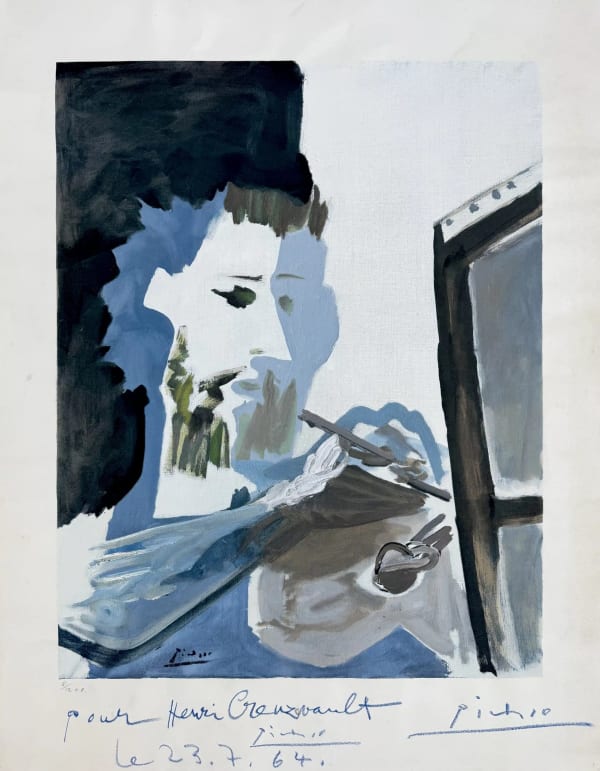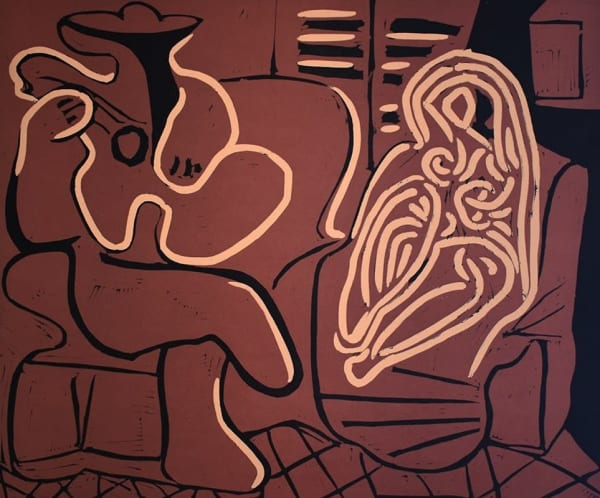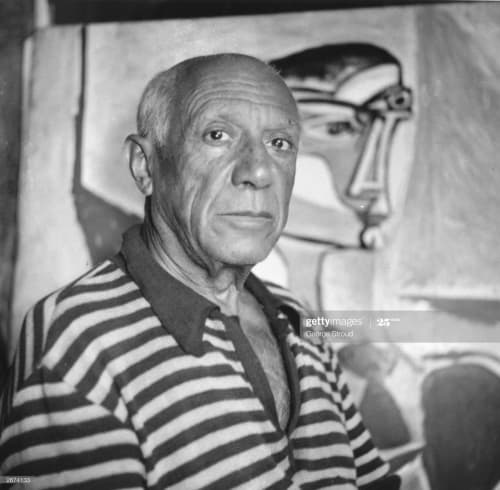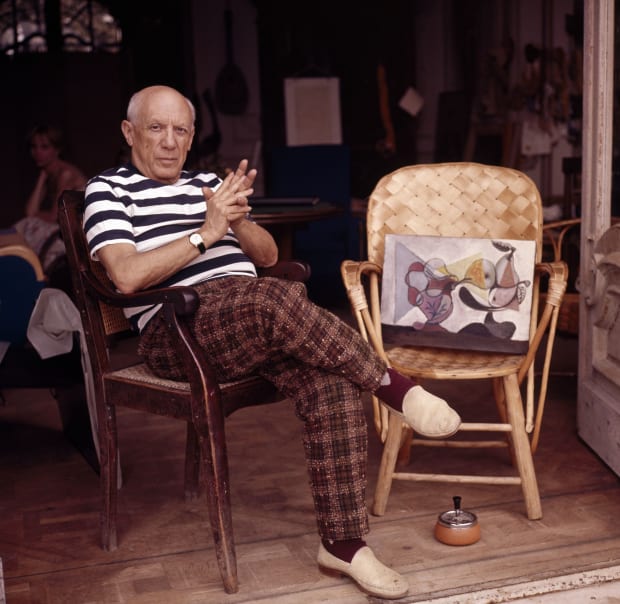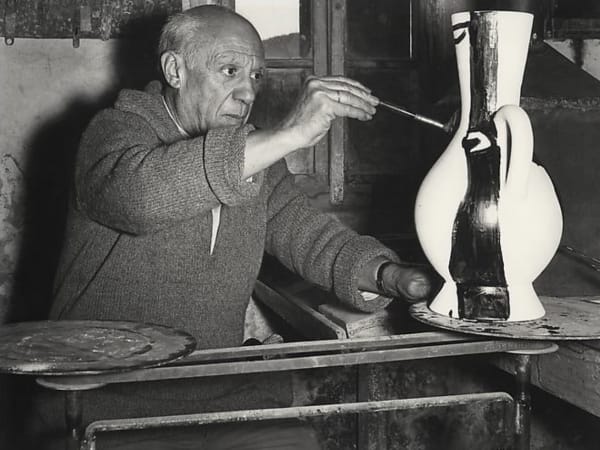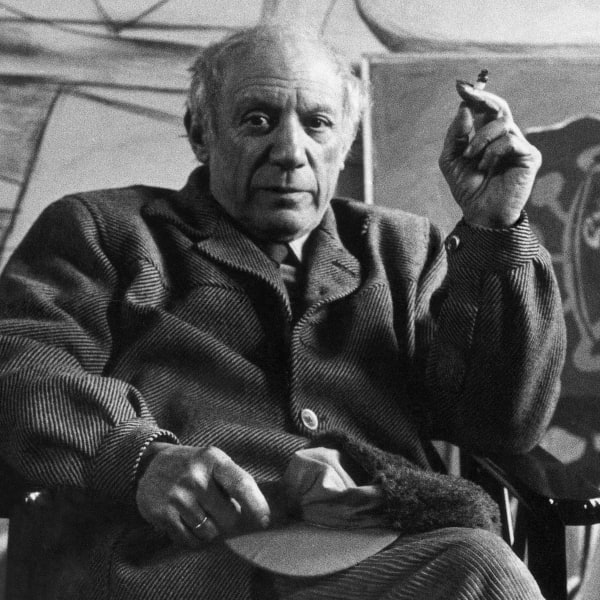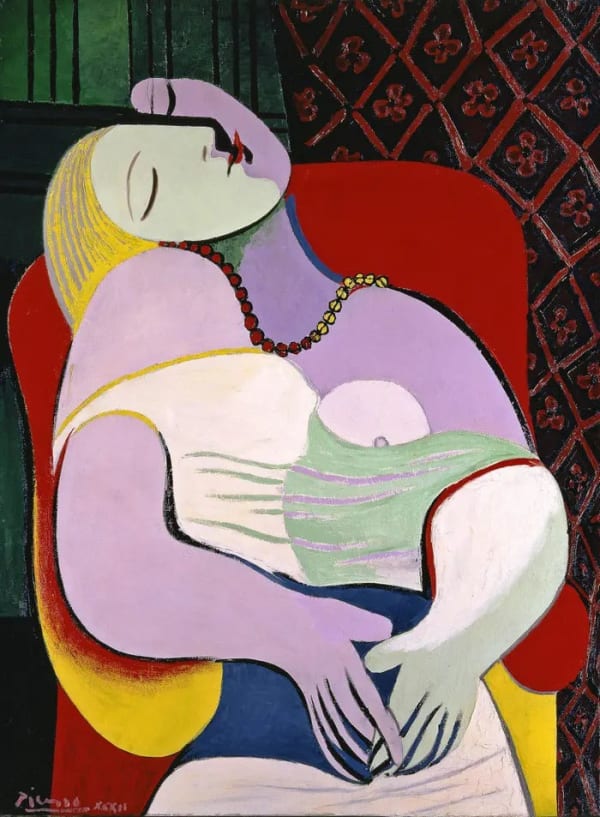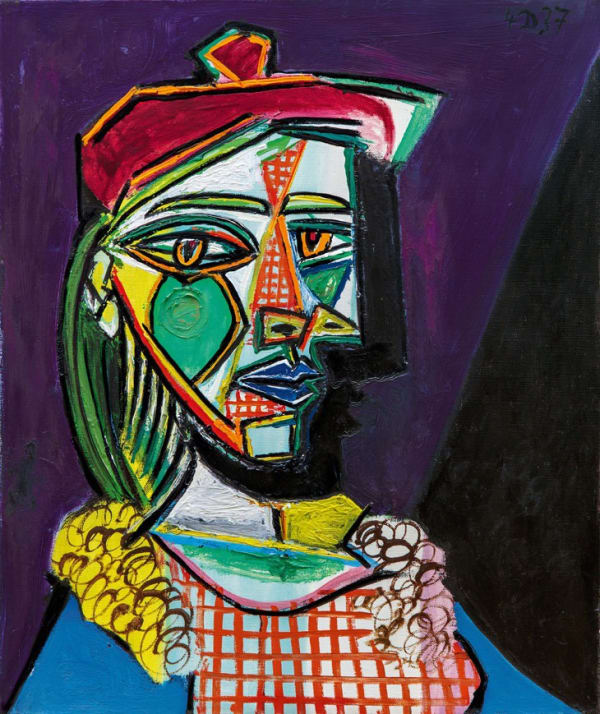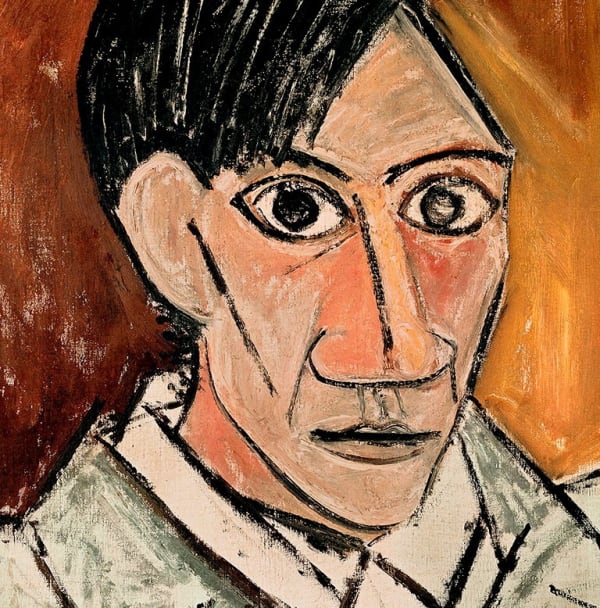-
Pablo Picasso Prints For Sale
Pablo Picasso's art reshaped the very notion of art itself through his groundbreaking exploration of form, color and shape which, decades after the artist's passing, still looks as revolutionary today as upon its creation. His iconic approach to form and line across his work witnesses the artist explore the very nature of the indelible creativity of the human spirit. Explore our latest Pablo Picasso art for sale at Guy Hepner, Picasso dealers since 2010.
Discover authentic Picasso lithocuts, prints and ceramics for sale below.
-
Original Picasso Signed Aquatints, Etchings and Lithographs For Sale
-
Series

Pablo Picasso
Le Peintre, 1963Collotype with pochoir in colors, on Arches- cadastre paper(with Watermark)
Hand signed and dedicated in blue crayon38 5/8 x 29 3/8 in
98.1 x 74.6 cmEdition of 350 and 12 H.CSeries: CollotypeCopyright The ArtistLe Peintre is a luminous example of Pablo Picasso’s mature synthesis of portraiture, abstraction, and self-referential commentary. Created in 1964 and dedicated to the French bookbinder and bibliophile Henri Creuzevault,...Le Peintre is a luminous example of Pablo Picasso’s mature synthesis of portraiture, abstraction, and self-referential commentary. Created in 1964 and dedicated to the French bookbinder and bibliophile Henri Creuzevault, this collotype fuses painterly gesture with conceptual play. Though executed in a printed medium, Le Peintre retains the fluidity, spontaneity, and textural subtlety characteristic of Picasso’s hand-drawn works, revealing his deep engagement with the printed image as a site of both technical mastery and expressive freedom.
Rendered in a restrained palette of cool blues, greys, and blacks, the composition features a semi-abstracted figure of an artist at work—his head bowed in concentration, palette and brush in hand, gazing into a mirror or possibly a canvas. The facial features, softly modeled yet angular, shift between figuration and abstraction. The light and shadow split the form nearly in half, with the right side dominated by an ethereal, near-ghostly glow and the left emerging from a dense black backdrop.
This duality of light and dark, presence and absence, is central to the work. The artist figure—likely a surrogate for Picasso himself—appears to dissolve into his surroundings, evoking the act of artistic creation as a merging of self and subject. The hand and arm are especially striking: fluid, ghostlike, almost transparent, as though painted in water or smoke, contrasting with the solidity of the easel or mirror structure to the right.
The flat planes, faceted geometry, and ambiguous spatial depth echo Cubist principles, but without the rigid analytical fragmentation of Picasso’s early 1910s Cubism. Instead, there is a lyrical, almost surreal quality here—soft, intuitive, and emotionally charged. This is Picasso the elder magician, painting the act of painting, caught in a moment of quiet introspection.
Le Peintre is executed in collotype, a high-fidelity photomechanical process used primarily for reproducing paintings and drawings with great accuracy. While not an original lithograph or etching in the traditional sense, the collotype process allowed Picasso to translate his painterly effects—his brushstrokes, tonal gradations, and layered pigment—into a printed form without losing the visual integrity of the original image.
Unlike the more graphic, linear print techniques he often employed in the 1930s and 1940s (etching, aquatint, lithography), this work emphasizes his painterly maturity and reflects a desire to merge traditional studio painting with the reproducibility of modern media. Picasso embraced the possibilities of printmaking not just as a reproductive tool but as an experimental platform, where he could test out ideas, embrace spontaneity, and reach wider audiences.
By the 1960s, Picasso had entered what some critics call his “late style,” characterized by expressive freedom, autobiographical references, and a return to themes of the artist and his studio. This piece fits within that narrative. The image of the artist—alone, focused, and surrounded by the tools of his craft—recalls earlier depictions of himself and others in the act of creation, from his Blue Period portraits of bohemian life to his Atelier series and final self-representations.
There is also a sense of circularity. At this stage of his life, Picasso was increasingly reflecting on his own legacy, his image, and his relationship to the history of painting. Le Peintre is both intimate and monumental—less about spectacle, more about the internal, meditative state of making art.
Le Peintre is a refined, contemplative tribute to the creative process, filtered through the eyes of one of the 20th century’s most prolific and inventive artists. It exemplifies Picasso’s lifelong commitment to redefining artistic language, not only through painting and sculpture, but also through his deep and nuanced engagement with printmaking. In this work, he merges medium and meaning, capturing the solitude and sublimity of the painter at work—a timeless archetype, yet unmistakably Picasso.
For more information, contact our galleries via the inquiry form below.
Overview"Prints are like a diary of my artistic journey."
Discover authentic and rare Picasso linocuts, prints and ceramics for sale at Guy Hepner New York & London.
Pablo Picasso (1881–1973) is one of the most influential artists of the 20th century. As a co-founder of Cubism and a pioneer of modern art, Picasso's legacy spans multiple disciplines—painting, sculpture, drawing, printmaking, and ceramics. Few artists matched his innovation or productivity.
In 1958, at the age of 77, Picasso relocated to the South of France with Jacqueline Roque. No longer working from his Paris studio, he discovered a local printer and began exploring linocut printing—a bold, graphic technique that involves carving designs into linoleum blocks.
Over the next five years, he created more than 100 linocuts, many of which are now considered essential examples of mid-century modern printmaking. The most collectable works include: Portrait of a Woman after Cranach the Younger (1958), Portrait of a Woman in a Hat* (1962) and Still Life with Glass Under the Lamp (1962) which are considered standout examples of Picasso’s linocut and printmaking technique.
Alongside his printmaking, Picasso immersed himself in the world of ceramic, working with the Madoura Pottery studio in Vallauris, he produced over 3,500 ceramic works starting in the mid-1940s. Picasso ceramics range from playful plates and jugs to complex sculptural forms. These works often feature animals, faces, and mythological symbols, executed in a signature style that is unmistakably Picasso.
Today, collectors are increasingly drawn to Picasso ceramics for their charm, provenance, and investment potential. Whether you're looking for editioned ceramics or unique studio pieces, Picasso's ceramic works offer a tangible connection to his genius.
Guy Hepner offer a curated selection of authentic Picasso linocuts for sale and Picasso ceramics for sale, complete with provenance and authentication documents. Whether you're looking for a standout linocut or a rare ceramic piece from Madoura, our experienced team is here to help you find the perfect Picasso addition to your collection.
For more information on Picasso prints for sale or to buy Picasso ceramics, contact our galleries via info@guyhepner.com. News
News-

2025 In Review: Picasso, Warhol, Basquiat, Haring.
Game Changers December 16, 2025In 2025, the markets for Pablo Picasso , Andy Warhol , Jean-Michel Basquiat , and Keith Haring remain not only resilient, but structurally essential to...Read more -

Pablo Picasso: Reinventing Portraits
Radical Lines. November 17, 2025Portraiture has served as one of its most stable and recognisable genres. From the idealised heads of Renaissance nobility to the psychological interiors crafted by...Read more -

Collecting Picasso Ceramics
A Global Market Report October 20, 2025Picasso's ceramics have evolved from a niche collecting category into a vibrant global market. Collectors worldwide are increasingly drawn to these works, which range from...Read more -

Top Performing Artists at Auction (2000–2025) A Guide
The Most Popular Artists at Auction and In the Global Art Market 2025 11/11/2025What Makes an Artist “Top Performing” From 2000 to 2025, the global art market has seen booms, corrections, and transformations. Throughout it all, certain artists...Read more -

Pablo Picasso: Market Performance 2005–2025
A Collector's Deep Dive September 8, 2025From 2005 to 2025, Picasso remained a bellwether of the global art market—highly liquid across price bands, with periodic record-setting trophies at the top and...Read more -

Picasso and the Reinvention of Art
How the Past Shaped a New Visual Language August 6, 2025Pablo Picasso’s name is virtually synonymous with modern art, but his genius didn’t come from a rejection of tradition. Quite the opposite: he absorbed the...Read more -

Why Picasso Still Matters
Understanding His Impact on Art and Culture August 6, 2025Few artists have reshaped the trajectory of modern art like Pablo Picasso. A name synonymous with innovation, rebellion, and sheer creative force, Picasso remains a...Read more -

Guide To Collecting Pablo Picasso
Where To Start? May 20, 2025Pablo Picasso is often hailed as the most influential artist of the 20th century, not only for his pioneering of Cubism but also for his...Read more -

Picasso Market Report
May 2025 May 20, 2025In the ever-evolving world of art investment, blue-chip artists like Pablo Picasso continue to offer a rare combination of cultural prestige and market resilience. In...Read more







